Plaque removal is important to keep your teeth healthy. Plaque causes a buildup of tartar on your teeth. It can lead to cavities, gingivitis, and other dental problems.
You can remove plaque by taking care of your teeth at home, including brushing twice a day and flossing once a day. When plaque hardens into tartar buildup, it can only be removed by a dentist.
This article discusses the symptoms and causes of plaque and tartar. It also covers ways to remove plaque and how to prevent it from becoming tartar buildup.
What Is Plaque?
Plaque is a kind of sticky film found on the teeth. It forms when the bacteria in the mouth is mixed with sugary or starchy food and drinks. The bacteria in the mouth, acids, and carbohydrates from food or drinks mix together and form into this colorless substance.
Plaque has to be removed regularly or it can harden into tartar and lead to dental complications. Some types of plaque can cause cavities while other types of plaque affect the gums.1
Symptoms of Plaque Buildup
The symptoms of plaque include:2
A fuzzy feeling on the teeth
Chronic bad breath
Tender, red, or swollen gums that may bleed when brushing
Signs of Tartar on Teeth
The symptoms of tartar include:34
A rough feeling on the teeth
Yellow discoloration of teeth2
Swollen gum tissue
Gums that bleed easily
Causes of Plaque Buildup
Plaque is constantly forming on the teeth. Drinks like milk, juice, and soda, and foods like fruit, pasta, and bread contain carbohydrates. When consumed, bacteria found in the mouth release a kind of acid to help break down these carbohydrates. These acids, together with the bacteria and carbohydrates, combine together to form plaque.2
If plaque isn’t removed from daily brushing and cleaning between the teeth, it starts to build up and hardens into tartar.4
Diagnosing Plaque
Plaque can be diagnosed by a dentist in a routine dental checkup.
During an appointment, the dentist or hygienist will examine the mouth and gums and also ask about your medical history. Depending on the circumstances, the dentist or hygienist may use instruments to inspect the gums.
The dentist or hygienist will be able to identify plaque and tartar just by examining the mouth and gums. No special tests are needed for this. Depending on what they find, they may recommend an X-ray to check for cavities.5
How to Remove Plaque
Plaque can be removed with good oral hygiene. This includes brushing and flossing every day using the proper methods. By removing plaque, you can prevent tartar from forming. If tartar does form, your dentist can remove it during your regular appointment.
continued on next page

